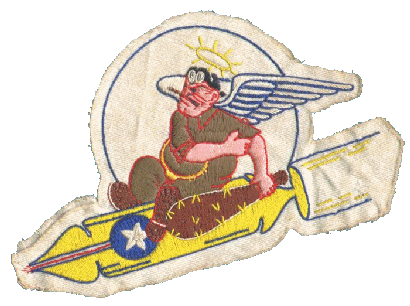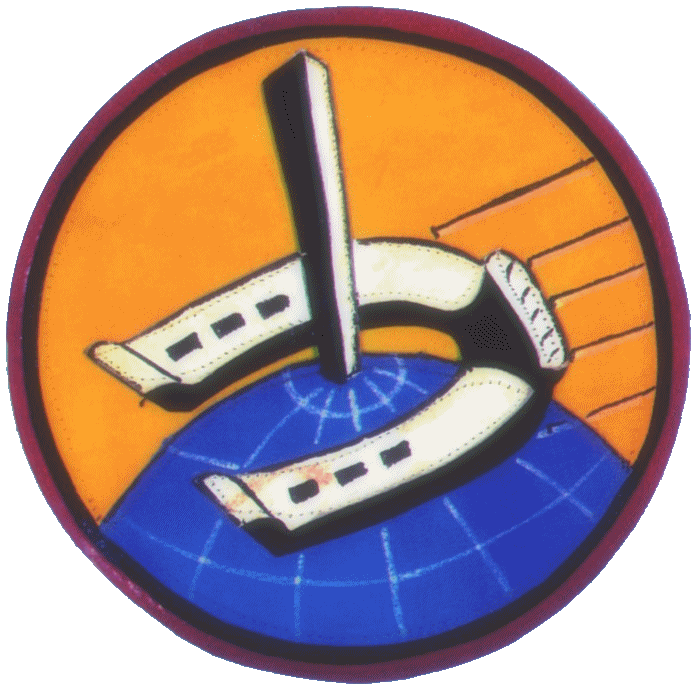Organized as 79th Aero Squadron on 15 August 1917. Redesignated 491st Aero Squadron on 1 Feb 1918; demobilized on 31 Jan 1919. Reconstitued and combined with 491st Bombardment Squadron which was constituted and alloted to the reserve on 31 March 1924. Disbanded on 31 May 1942.
The 491st Bombardment Squadron (M) was constituted and authorized to be made active, pursuant to War Department letter dated 14 Aug 42. On 16 Sep 42, General Order No. 42, Headquarters, Tenth American Air Force, New Delhi, India activated the Squadron at Karachi, India. Major Blair M. Sorenson was named its first Commanding Officer, and it became a unit of the 341st Bombardment Group, along with the 11th, 22nd and 490th Squadrons.
The squadron cadre moved to Chakulia, India early in 1943. Prior to this point, the WW II history of the 491st is the history of the 22nd Bombardment Squadron. In early 1943, the 22nd was split into two to provide the general personnel for its sister squadron, the 491st. From then on, the 491st created its own history.
Both Squadrons remained at Chakulia during 1943, with missions against freight and Japanese troop facilities throughout Burma and the Bay of Bengal. The 491st operated missions over Burma from there and from various staging areas. Major Edward M. Garret succeeded Major Sorenson as C.O. on March 29, 1943 when Maj. Sorenson became group operations office. In July and August of 1943 a considerable part of the Squadron's ground personnel served with a training unit of the Air Transport Command at Gaya, while the Squadron itself continued to operate successfully through the monsoon season with only a skeleton ground force serving the combat men.
The Ringer outfit was probably the first squadron of any type in the CBI theater to use all sixteen of its aircraft on a single mission and was frequently commended by the Tenth Air Force officials for its high standard of aircraft maintenance.
Plans to transfer the Squadron to China and the Fourteenth Air Force, late in 1943, caused both the 491st and the 22nd to be ordered to cut back to "skeleton" squadrons. The 491st retained between half and two-thirds of the personnel that a normal medium operational squadron would have. Since the only source of supplies to China was Air Transport Command flying the Hump, space on the transports was pretty much reserved for aircraft parts, gasoline and ammunition. Gen Chennault did not want the space needed for these essential materials to be occupied by more than a minimum number of men and therefore directed a limited number of personnel be transported by aircraft over the mountains and wilderness of the Himalayan range." Consequently, from that time on, all guards and general detailed personnel were supplied by the Chinese rather than by U.S.A.A.F. personnel.
The Squadron's move to Yangkai, in Yunan Province, China, began early in January 1944 and by the end of February virtually all of the organization's personnel and equipment were at their new base. The squadron one aircraft and three of its men over "the Hump" while ferrying equipment.
With the 341st Bomb Group, under command of the 69th Composite Group, the 491st performed its missions for the 14th Air Force. From February 1944 thru 15 Sep 1945 the squadron carried out missions over China, French Indo China, Thailand and Burma, New Guinea and the South China Sea. The last reported combat mission included 3 B-25s from the 22nd Bomb Squadron and 1 B-25, piloted by Capt Walker, from the 491st, in an attack on the Vinh railyards. We believe that Capt Walker also piloted the 491st's last reported CBI mission, which was a leaflet drop in the area of Liuchow, China.
The 491st Bomb Squadron was 'transferred' to Camp Kilmer, NJ, and inactivated 1 - 2 Nov 45.
In June 1997 Mckay Nelson, engineer-gunner with the 491st, published "Diary of A Bomb Squadron: A Tribute to 1080 Young Men". It is the historical chronicles of the highly decorated 491st Bomb Squadron, taken from the original orderly room historical reports.


